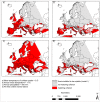Aedes albopictus and Its Environmental Limits in Europe
- PMID: 27603669
- PMCID: PMC5014377
- DOI: 10.1371/journal.pone.0162116
Aedes albopictus and Its Environmental Limits in Europe
Abstract
The Asian tiger mosquito Aedes albopictus, native to South East Asia, is listed as one of the worst invasive vector species worldwide. In Europe the species is currently restricted to Southern Europe, but due to the ongoing climate change, Ae. albopictus is expected to expand its potential range further northwards. In addition to modelling the habitat suitability for Ae. albopictus under current and future climatic conditions in Europe by means of the maximum entropy approach, we here focused on the drivers of the habitat suitability prediction. We explored the most limiting factors for Aedes albopictus in Europe under current and future climatic conditions, a method which has been neglected in species distribution modelling so far. Ae. albopictus is one of the best-studied mosquito species, which allowed us to evaluate the applied Maxent approach for most limiting factor mapping. We identified three key limiting factors for Ae. albopictus in Europe under current climatic conditions: winter temperature in Eastern Europe, summer temperature in Southern Europe. Model findings were in good accordance with commonly known establishment thresholds in Europe based on climate chamber experiments and derived from the geographical distribution of the species. Under future climatic conditions low winter temperature were modelled to remain the most limiting factor in Eastern Europe, whereas in Central Europe annual mean temperature and summer temperatures were modelled to be replaced by summer precipitation, respectively, as most limiting factors. Changes in the climatic conditions in terms of the identified key limiting factors will be of great relevance regarding the invasive potential of the Ae. albopictus. Thus, our results may help to understand the key drivers of the suggested range expansion under climate change and may help to improve monitoring programmes. The applied approach of investigating limiting factors has proven to yield valuable results and may also provide valuable insights into the drivers of the prediction of current and future distribution of other species. This might be particularly interesting for other vector species that are of increasing public health concerns.
Conflict of interest statement
The authors have declared that no competing interests exist.
Figures





References
-
- Caminade C, Medlock JM, Ducheyne E, McIntyre KM, Leach S, Matthew B et al. (2012) Suitability of European climate for the Asian tiger mosquito Aedes albopictus: recent trends and future scenarios. Journal of the Royal Society, Interface / the Royal Society 9 (75): 2708–2717. 10.1098/rsif.2012.0138 - DOI - PMC - PubMed
-
- Medlock JM, Avenell D, Barrass I, Leach S (2006) Analysis of the potential for survival and seasonal activity of Aedes albopictus (Diptera. Culicidae) in the United Kingdom. Journal of Vector Ecology 31 (2): 292–304. - PubMed
MeSH terms
LinkOut - more resources
Full Text Sources
Other Literature Sources

